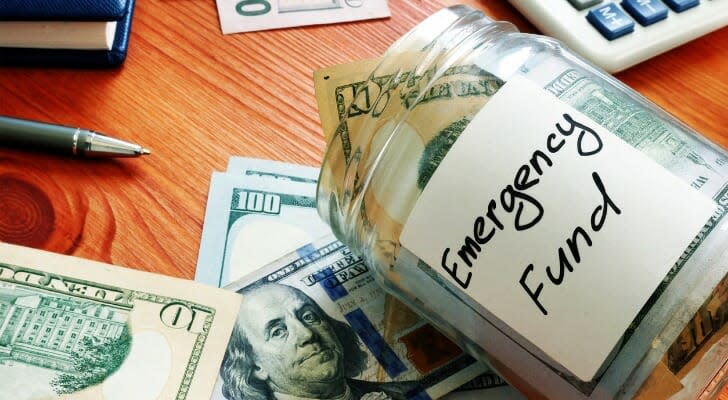
One of the biggest threats to your retirement savings isn’t inflation, a stock market swoon or even bad investment picks – it’s you.
That’s because when a financial crisis hits, many workers start draining their retirement accounts in order to find the cash to cope. It’s not news that 32% of Americans can’t handle an emergency that requires them to come up with $400 in cash. Meanwhile, the average financial emergency in 2021 cost $1,400, according to research from LendingClub Corp.
And for 43% of Americans, their retirement money is the only emergency savings available, according to Voya Financial, a financial, retirement, investment and insurance company.
That’s why establishing and building an emergency fund is one of the most important steps in building a secure retirement.
A financial advisor can help you build an emergency and provide valuable advice for avoiding financial emergencies. Find a fiduciary advisor today.
If you don’t build up an emergency fund, you end up relying on credit cards, payday loans or your retirement savings to cover emergency expenses. Workers without an emergency fund are 13 times more likely to make a hardship withdrawal, according to Voya, and also are more likely to reduce their retirement contributions.
Why You Need an Emergency Fund

Covering a $5,000 emergency expense with a hardship withdrawal from a retirement account creates a number of issues. First, hardship withdrawals are taxable as income, meaning you’ll have to withdraw more than $5,000 in order to pay the taxes you’ll owe on the distribution. And in some cases, you’ll still be subject to an extra 10% early withdrawal penalty. For example, early withdrawals that are used to pay for health insurance premiums while unemployed still trigger the 10% penalty.
Additionally, the withdrawal means that money will no longer be generating compound interest, reducing the ultimate size of your retirement nest egg.
The result is that as they near retirement, people without emergency funds find themselves with lower account balances and the possibility of needing to work additional years before they can afford to retire.
Workplace accounts such as 401(k) plans often allow contributors to take loans against their accounts, which avoid taxes and penalties, but also lower the invested balance. In addition, if the borrower leaves the company, the entire loan balance often becomes payable. If it isn’t paid off, the loan is treated as a withdrawal, subject to taxes and penalties.
If you’re ready to be matched with local advisors that can help you achieve your financial goals, get started now.
How to Build an Emergency Fund

The key to establishing an emergency account is to start with small, regular automated deposits to a dedicated bank savings account. You’ll want to gradually increase your contribution rate over time, adding at least part of any raises, bonuses or other windfalls that you receive along the way. The starting rate can be as low as 2% with a regular 1% increase every year or six months.
The minimum goal for an emergency account should be the equivalent of three months’ worth of living expenses, but it’s much safer to have six months of your salary or even a year’s worth of income set aside. Emergency cash should be deposited in savings accounts where the balance will be stable and can be easily accessed in an emergency, unlike stocks and other investments. The account should be kept separate from accounts used for regular spending and household bills.
One big opportunity to start – or increase – an emergency fund comes during tax season. According to the IRS, the average refund this filing season is $2,903. That could give you a nice foundation for an emergency fund or help add to what you already have saved.
Bottom Line
An emergency fund helps protect your retirement nest egg by giving you options in a financial crisis that don’t involve raiding your retirement savings. Without an emergency fund, workers are more like to make hardship withdrawals, take out loans or reduce their retirement contributions, which can all result in diminished retirement savings.
Tips for Being More Financially Stable
From building an emergency fund to planning for retirement, a financial advisor can help you in your financial journey. Finding a financial advisor doesn’t have to be hard. SmartAsset’s free tool matches you with up to three vetted financial advisors who serve your area, and you can interview your advisor matches at no cost to decide which one is right for you. If you’re ready to find an advisor who can help you achieve your financial goals, get started now.
SmartAsset has a variety of free tools that can help you become more financially secure. Our rent vs. buy calculator can help you decide which housing option is more appropriate for you, while our retirement calculator can give you valuable insight into how much money you may need to retire comfortably. For retirees or those approaching retirement, our tax-friendliness tool can help you assess which states are most and least hospitable for retirees when it comes to taxes.
Photo credit: ©iStock.com/AsiaVision, ©iStock.com/designer491, ©iStock.com/fizkes
The post No Emergency Fund? Your Retirement Is at Risk appeared first on SmartAsset Blog.
Source: https://finance.yahoo.com/news/no-emergency-fund-retirement-risk-154416051.html